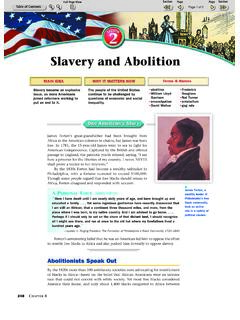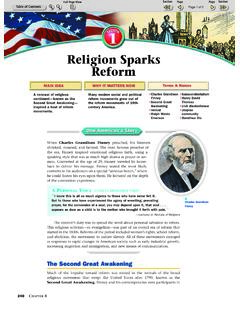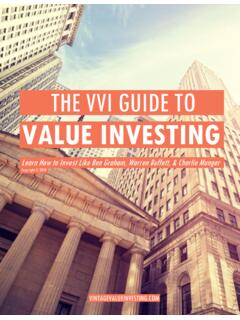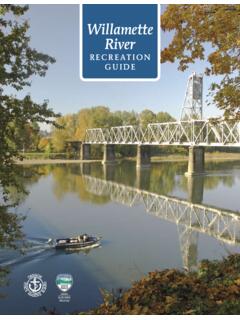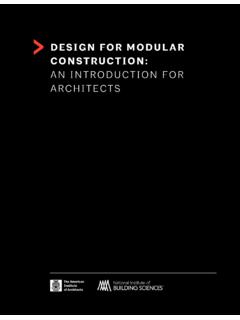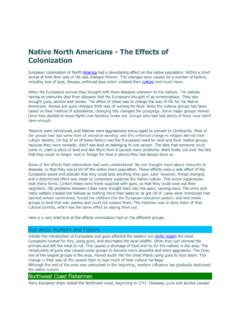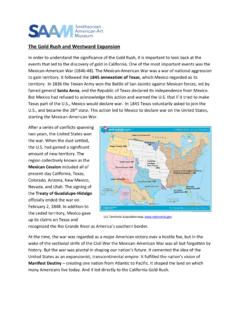Transcription of The Divisive Politics of Slavery - Caggia Social Studies
1 304 CHAPTER10 One American's StoryThe Divisive Politicsof SlaverySouth Carolina senator John C. Calhoun was so sick that he had missedfour months of debate over whether California should enter the Unionas a free state. On March 4, 1850, Calhoun, explaining that he was tooill to deliver a prepared speech, asked Senator James M. Mason ofVirginia to deliver it for PERSONALVOICEJOHN C. CALHOUN I have, Senators, believed from the first that the agitation of thesubject of Slavery would, if not prevented by some timely and effec-tive measure, end in disunion.. The agitation has been permittedto proceed .. until it has reached a period when it can no longer bedisguised or denied that the Union is in danger. You have thus hadforced upon you the greatest and the gravest question that can evercome under your consideration: How can the Union be preserved? quoted in The Compromise of 1850, edited by Edwin C.
2 RozwencSenator Calhoun called on the North to give the South justice, simplejustice. He demanded that Slavery be allowed throughout the territorieswon in the war with Mexico. If it was not, he declared, the South would secede,or withdraw, from the Union. Once again, the issue of Slavery had brought abouta political crisis, deepening the gulf between the North and the Between North and SouthSenator Calhoun argued that although the North and the South had been politi-cally equal when the Constitution was adopted, the perfect equilibrium between the two sections no longer existed. At any rate, the two sections certain-ly had developed different ways of life by the AND IMMIGRATION IN THE NORTHThe North industrializedrapidly as factories turned out ever-increasing amounts of products, from textilesand sewing machines to farm equipment and guns.
3 Railroads with more than20,000 miles of track laid during the 1850s carried raw materials eastward andTerms & NamesTerms & NamesMAIN IDEAMAIN IDEAThe issue of slaverydominated Politics inthe early society continues to bechallenged by issues offairness, equality, race, andclass. WHY IT MATTERS NOWWHY IT MATTERS NOW John C. Calhounwas vice-president underJohn QuincyAdams andAndrew last wordswere: The poor South. Wilmot Proviso secession Compromise of1850 popularsovereignty Stephen Millard Fillmorep0304-309aspe-0310s1 10/16/02 4:05 PM Page 304 Amanufactured goods and settlers westward. Small towns like Chicago maturedinto cities almost overnight, due to the sheer volume of goods and people arrivingby railroad. Telegraph wires strung along the railroad tracks provided a networkof instant communication for the from Europe entered the industrial workplace in growing num-bers.
4 Many became voters with a strong opposition to Slavery . They feared theexpansion of Slavery for two main reasons. First, it might bring slave labor intodirect competition with free labor, or people who worked for wages. Second, itthreatened to reduce the status of white workers who could not successfully com-pete with slaves. AGRICULTURE AND Slavery IN THE SOUTHU nlike the North, the Southremained a predominantly rural society, consisting mostly of plantations andsmall farms. The Southern economy relied on staple crops such as cotton. Thoughone-third of the nation s population lived in the South in 1850, the South pro-duced under 10 percent of the nation s manufactured goods. At the same timethat Northern railroad lines were expanding, Southerners were mostly using riversto transport goods. In addition, few immigrants settled in the South, becauseAfrican Americans, whether enslaved or free, met most of the available need forartisans, mechanics, and laborers.
5 Those immigrants who did settle in the South,however, displayed significant opposition to Slavery . For example, German-American newspapers in Texas and in Baltimore, Maryland published editorialsin favor of universal voting rights and freedom for African conflict over Slavery rattled Southern society. In three Southern states,Mississippi, Louisiana, and South Carolina, African Americans were in the major-ity. In Alabama and Florida, African Americans composed almost half of the pop-ulation. While blacks dreamed of an end to Slavery , many Southern whites fearedthat any restriction of Slavery would lead to a Social and economic , Calhoun warned that such a revolution would condemn blacks aswell as whites to the greatest calamity, and the [South] to poverty, desolation,and wretchedness. The Union in Peril305 MAIN IDEAMAIN IDEAAC ontrastingList threeways in which theNorth and theSouth differed inthe mid AnswerTheNorth had anindustrial ratherthan agriculturaleconomy; theNorth mostlyopposed Slavery ,while the Southrelied on slavelabor; the Northhad more urbangrowth as wellas more growthin ThroughHistory ThroughGREEK REVIVAL ARCHITECTUREThe Greek Revival was an architectural style that spread throughout the UnitedStates between 1825 and 1860.
6 Like ancient Greek temples, many buildingsin this style had columns on all four sides. This style was applied to all typesof buildings in Greek Revival architecture, from small houses to state hot, humid climate of the South encouraged the development of a highporch and with columns rising to the full height of a building. These wide porches were unusual in the cooler climate of Europe but well-suited to tropical regions. In the hands of Greek Revival architects in the South, the porches became grand living spaces where families could find shelter from the summer Visual Sources1. How would you be able to tell that this home is an example of the Greek Revival style?2. How did the architecture help cool the house?SEE SKILLBUILDER HANDBOOK, PAGE Alley Plantation, Louisiana p0304-309aspe-0310s1 10/16/02 4:05 PM Page 305 CSlavery in the TerritoriesOn August 8, 1846, Pennsylvania Democrat David Wilmot heightened tensionsbetween North and South by introducing an amendment to a military appropri-ations bill proposing that neither Slavery nor involuntary servitude shall everexist in any territory the United States might acquire as a result of the war withMexico.
7 In strictly practical terms, the Wilmot Provisomeant that California, aswell as the territories of Utah and New Mexico, would be closed to Slavery WILMOT PROVISOThe Wilmot Proviso divided Congress along regionallines. Northerners, angry over the refusal of Southern congressmen to vote forinternal improvements, such as the building ofcanals and roads, supported the proviso. They alsofeared that adding slave territory would give slavestates more members in Congress and deny eco-nomic opportunity to free workers. Southerners, as expected, opposed the proviso,which, some argued, raised complex constitutionalissues. Slaves were property, Southerners claimed,and property was protected by the like the Wilmot Proviso would underminesuch constitutional Southerners feared that if the WilmotProviso became law, the inevitable addition of newfree states to the Union would shift the balance ofpower permanently to the North.
8 The House ofRepresentatives approved the proviso, but theSenate rejected it. Congressman Alexander of Georgia issued a dire PERSONALVOICEALEXANDER H. STEPHENS The North is going to stick the Wilmot amendment to every appropriation andthen all the South will vote against any measure thus clogged. Finally a tremen-dous struggle will take place and perhaps [President] Polk in starting one warmay find half a dozen on his hands. I tell you the prospect ahead is dark, cloudy,thick and gloomy. quoted in The Coming of the Civil WarSTATEHOOD FOR CALIFORNIAAs a result of the gold rush , California hadgrown in population so quickly that it skipped the territorial phase of becominga state. In late 1849, California held a constitutional convention, adopted a stateconstitution, elected a governor and a legislature, and applied to join the Union. California s new constitution forbade Slavery , a fact that alarmed manySoutherners.
9 They had assumed that because most of California lay south of theMissouri Compromise line of 36 30 , the state would be open to Slavery . They hadhoped that the compromise, struck in 1820, would apply to new territories,including California, which would have become a slave Zachary Taylor, who succeeded Polk as presidentin 1849, supported California s admission as a free , he felt that the South could counter abolitionismmost effectively by leaving the Slavery issue up to individualterritories rather than to Congress. Southerners, however,saw this as a move to block Slavery in the territories and as anattack on the Southern way of life and began to questionwhether the South should remain in the sadmission to theUnion in 1850increasedtensions betweenNorth and South. B306 CHAPTER10 SkillbuilderAnswerAbout 63%. MAIN IDEAMAIN IDEABA nalyzingMotives Explain whyNorthernersfavored the WilmotProviso and whySoutherners did AnswerNorthernerswanted to pre-vent the expan-sion of slaveryinto the territo-ries, because itmight causemore slavestates to enterthe didnot want Con-gress decidingthe issue AnswerAlthough mostCalifornia votersopposed Slavery ,most of the statelay south of theMissouriCompromiseline, and there-fore legallyshould havebeen open IDEAMAIN IDEACA nalyzingEffects Why didCalifornia sapplication forstatehood causean uproar?
10 Members Members Year from Free from Slave States States1800 77 651810 105 811820 123 901830 142 1001840 141 911850 144 90 Source: Historical Statistics of the United StatesSKILLBUILDERI nterpreting ChartsAbout what percentage of House members represented free states in 1850?Membership in House of Representativesp0304-309aspe-0310s1 10/16/02 4:05 PM Page 306 The Senate DebatesThe 31st Congress opened in December 1849 in an atmosphere of distrust andbitterness. The question of California statehood topped the agenda. Of equal con-cern was the border dispute in which the slave state of Texas claimed the easternhalf of New Mexico Territory, where the issue of Slavery had not yet been the meantime, Northerners demanded the abolition of Slavery in the Districtof Columbia, while Southerners accused the North of failing to enforce theFugitive Slave Act of 1793.

